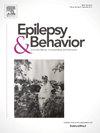Reading and language profiles among children with epilepsy
IF 2.3
3区 医学
Q2 BEHAVIORAL SCIENCES
引用次数: 0
Abstract
This study evaluated the profile of language and reading skills among children with epilepsy. We utilized a sample of children from an epilepsy database who were administered a measure of reading comprehension, excluding those whose intellectual skills were in the impaired range (N=147; age range 4–20 years, 52 % female). Additional measures that were considered within the sample included broad language skills, pre-reading skills (phonological processing, rapid naming, decoding), and basic reading skills (sight word reading, reading fluency). We further considered associations between these skills and seizure characteristics (age of onset, number of anti-seizure medications, seizure type, seizure frequency, and localization). We found that our sample performed significantly lower on all language and reading skills, on average, than normative expectations. Within our sample, relative strengths were noted in broad language skills, and relative weaknesses were found in phonological processing, rapid naming, reading fluency, word reading, and reading comprehension. We further identified a subgroup of our sample (31 %) who were characterized as struggling in reading comprehension (performing one standard deviation below the normative mean); these children exhibited a profile more consistent with non-epilepsy samples with reading disabilities/ dyslexia. Seizure variables that were associated with language and reading skills included age of onset, number of anti-seizure medications, seizure frequency, and having generalized (versus focal) seizures. These results have important implications for the identification and treatment of reading problems in children with epilepsy.
癫痫儿童的阅读和语言概况
本研究评估了癫痫儿童的语言和阅读能力概况。我们利用癫痫数据库中的儿童样本,对他们进行了阅读理解能力测量,并排除了智力受损的儿童(样本数=147;年龄范围为 4-20 岁,52% 为女性)。在样本中考虑的其他测量包括广泛的语言技能、前阅读技能(语音处理、快速命名、解码)和基本阅读技能(视词阅读、阅读流畅性)。我们进一步考虑了这些技能与癫痫发作特征(发病年龄、服用抗癫痫药物的次数、癫痫发作类型、发作频率和定位)之间的关联。我们发现,我们的样本在所有语言和阅读技能方面的平均表现明显低于常模期望值。在我们的样本中,广泛的语言技能相对较强,而语音处理、快速命名、阅读流畅性、单词阅读和阅读理解能力相对较弱。我们还在样本中发现了一个亚群(31%),他们在阅读理解方面表现挣扎(比常模平均值低一个标准差);这些儿童的表现与患有阅读障碍/诵读困难的非癫痫样本更为一致。与语言和阅读能力相关的癫痫发作变量包括发病年龄、服用抗癫痫药物的次数、癫痫发作频率以及全身性(相对于局灶性)癫痫发作。这些结果对识别和治疗癫痫儿童的阅读问题具有重要意义。
本文章由计算机程序翻译,如有差异,请以英文原文为准。
求助全文
约1分钟内获得全文
求助全文
来源期刊

Epilepsy & Behavior
医学-行为科学
CiteScore
5.40
自引率
15.40%
发文量
385
审稿时长
43 days
期刊介绍:
Epilepsy & Behavior is the fastest-growing international journal uniquely devoted to the rapid dissemination of the most current information available on the behavioral aspects of seizures and epilepsy.
Epilepsy & Behavior presents original peer-reviewed articles based on laboratory and clinical research. Topics are drawn from a variety of fields, including clinical neurology, neurosurgery, neuropsychiatry, neuropsychology, neurophysiology, neuropharmacology, and neuroimaging.
From September 2012 Epilepsy & Behavior stopped accepting Case Reports for publication in the journal. From this date authors who submit to Epilepsy & Behavior will be offered a transfer or asked to resubmit their Case Reports to its new sister journal, Epilepsy & Behavior Case Reports.
 求助内容:
求助内容: 应助结果提醒方式:
应助结果提醒方式:


